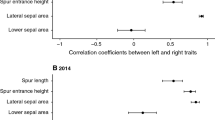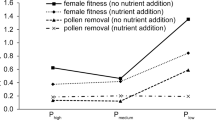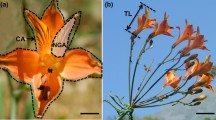Abstract
The staminal lever mechanism of pollination in Salvia has been considered as a key innovation, which was proposed to contribute to adaptive radiation of the genus. Considering its sophisticated interaction with pollinators, we hypothesized that relevant floral traits in the lever mechanism might be subject to intense selection in natural populations. In the present study, Salvia digitaloides was employed to investigate phenotypic selection on the floral traits. The results indicated that there were large variations in the floral structural traits and spatial position of the stigma. No significant selection was detected on the plausible key trait, i.e. the stamen lever length. Strong stabilizing selection acted consistently on the size of corolla entrance; that is, the intermediate corolla entrance was at a selective advantage. Both corolla length and style exsertion were subject to opposite directional selection in both years; and corolla entrance height was subject to disruptive selection, which was attributed to divergent adaptation of the trait to different body-sized pollinators. Furthermore, correlational selection acted on a few pairs of traits which described corolla entrance size and stigma position. Flower production was consistently subject to significantly positive directional selection in both years. In conclusion, it was most likely that floral traits involved in the staminal lever mechanism evolved in a functionally integrated manner for the enhancement of pollination efficiency in the natural population of S. digitaloides.


Similar content being viewed by others
References
Aigner PA (2004) Floral specialization without trade-offs: optimal corolla flare in contrasting pollination environments. Ecology 85(9):2560–2569
Aigner PA (2006) The evolution of specialized floral phenotypes in a fine-grained pollination environment. In: Waser NM, Ollerton J (eds) Plant–pollinator interactions from specialization to generalization. The University of Chicago Press, Chicago, pp 23–46
Arnold SJ, Wade MJ (1984a) On the measurement of natural and sexual selection: applications. Evolution pp 720–734
Arnold SJ, Wade MJ (1984b) On the measurement of natural and sexual selection: theory. Evolution 38(4):709–719
Benitez-Vieyra S, Glinos E, Medina AM, Cocucci AA (2012) Temporal variation in the selection on floral traits in Cyclopogon elatus (Orchidaceae). Evol Ecol 26(6):1451–1468
Claßen-Bockhoff R, Crone M, Baikova E (2004a) Stamen development in Salvia L.: homology reinvestigated. Int J Plant Sci 165(4):475–498
Claßen-Bockhoff R, Speck T, Tweraser E, Wester P, Thimm S, Reith M (2004b) The staminal lever mechanism in Salvia L. (Lamiaceae): a key innovation for adaptive radiation? Org Divers Evol 4(3):189–205
Conner JK, Hartl DL (2004) A primer of ecological genetics. Sinauer Associates, Massachusetts
Conner JK, Via S (1993) Patterns of phenotypic and genetic correlations among morphological and life-history traits in wild radish, Raphanus raphanistrum. Evolution 47(3):704–711
Conner JK, Rice AM, Stewart C, Morgan MT (2003) Patterns and mechanisms of selection on a family-diagnostic trait: evidence from experimental manipulation and lifetime fitness selection gradients. Evolution 57(3):480–486
Correns C (1891) Zur Biologie und Anatomie der Salvienblüthe. Pringsheims Jahrbücher für wissenschaftliche Botanik 22:190–240
Darwin C (1859) The origin of species by means of natural selection: or, the preservation of favored races in the struggle for life. A.L. Burt (1910), New York
Darwin CR (1862) On the various contrivances by which British and foreign orchids are fertilised by insects, and on the good effects of intercrossing. Murray, London
Gómez JM (2000) Phenotypic selection and response to selection in Lobularia maritima: importance of direct and correlational components of natural selection. J Evol Biol 13(4):689–699
Gómez JM, Zamora R (2006) Ecological factors that promote the evolution of generalization in pollination systems. In: Waser N, Ollerton J (eds) Plant-pollinator interactions: from specialization to generalization. The University of Chicago Press, Chicago, pp 145–166
Gómez JM, Bosch J, Perfectti F, Fernández JD, Abdelaziz M, Camacho JPM (2008) Spatial variation in selection on corolla shape in a generalist plant is promoted by the preference patterns of its local pollinators. Proc R Soc Lond B Biol Sci 275(1648):2241
Grant KA, Grant V (1964) Mechanical isolation of Salvia apiana and Salvia mellifera (Labiatae). Evolution 18(2):196–212
Harder LD, Johnson SD (2009) Darwin’s beautiful contrivances: evolutionary and functional evidence for floral adaptation. New Phytol 183(3):530–545
Herrera CM, Castellanos MC, Medrano M (2006) Geographical context of floral evolution: towards an improved research programme in floral diversification. In: Harder, LD, Barrett SCH (eds) Ecology and evolution of flowers, pp 278–294
Irwin RE (2006) The consequences of direct versus indirect species interactions to selection on traits: pollination and nectar robbing in Ipomopsis aggregata. Am Nat 167(3):315–328
Kingsolver JG, Hoekstra HE, Koekstra JM, Berrigan D, Vignieri SN, Hill CE, Hoang A, Gilbert P, Beerli P (2001) The strength of phenotypic selection in natural populations. Am Nat 157:245–261
Kleunen M, Burczyk J (2008) Selection on floral traits through male fertility in a natural plant population. Evol Ecol 22:39–54
Lande R, Arnold SJ (1983) The measurement of selection on correlated characters. Evolution 37(6):1210–1226
Linder HP (2008) Plant species radiations: where, when, why? Philos Trans R Soc Lond Ser B Biol Sci 363(1506):3097
Mitchell RJ (1994) Effects of floral traits, pollinator visitation, and plant size on Ipomopsis aggregata fruit production. Am Nat 143(5):870–889
Ohashi K (2002) Consequences of floral complexity for bumblebee-mediated geitonogamous self-pollination in Salvia nipponica Miq. (Labiatae). Evolution 56(12):2414–2423
Ordano M, Fornoni J, Boege K, Domínguez CA (2008) The adaptive value of phenotypic floral integration. New Phytol 179:1183–1192
R Development Core Team (2008) R: a language and environment for statistical computing. R Foundation for Statistical Computing, Vienna
Rausher MD (1992) The measurement of selection on quantitative traits: biases due to environmental covariances between traits and fitness. Evolution 46(3):616–626
Toland Ø (2001) Environment-dependent pollen limitation and selection on floral traits in an alpine species. Ecology 82(8):2233–2244
Trapp A (1956) Zur Morphologie und Entwicklungsgeschichte der Staubblätter sympetaler Blüten. Botanische Studien 5:1–93
Troll W (1929) Roscoea purpurea Sm., eine Zingiberacee mit Hebelmechanismus in den Blüten. Mit Bemerkungen über die Entfaltungsbewegungen der fertilen Staubblätter von Salvia. Planta 7(1):1–28
Walker JB, Sytsma KJ (2007) Staminal evolution in the genus Salvia (Lamiaceae): molecular phylogenetic evidence for multiple origins of the staminal lever. Ann Bot 100(2):375–391
Walker JB, Sytsma KJ, Treutlein J, Wink M (2004) Salvia (Lamiaceae) is not monophyletic: implications for the systematics, radiation, and ecological specializations of Salvia and tribe Mentheae. Am J Bot 91(7):1115–1125
Wester P, Claßen-Bockhoff R (2006) Bird pollination in South African Salvia species. Flora 201(5):396–406
Wester P, Claßen-Bockhoff R (2007) Floral diversity and pollen transfer mechanisms in bird-pollinated Salvia species. Ann Bot 100(2):401–421
Zhang B, Sun S, Zhang ZQ, Li QJ (2010) A review of the evolutionary and ecological significance of lever-like stamens. Chin J Plant Ecol 34(1):89–99
Zhang B, Claßen-Bockhoff R, Zhang ZQ, Sun S, Luo YJ, Li QJ (2011) Functional implications of the staminal lever mechanism in Salvia cyclostegia (Lamiaceae). Ann Bot 107(4):621–628
Zhang B, Sun S, Fang QE, Bai XM (2012) Evolutionary response of staminal lever mechanism of different species in Salvia to spatial variation in pollinators. Chin J Plant Ecol 36(7):681–689
Acknowledgments
We thank Zheng-Hua Xie for the identification of bumble-bee specimens, Regine Claßen-Bockhoff and two anonymous reviewers for their valuable comments on the manuscript, and Victor Squires for language polishing. This work was supported by National Basic Research Program of China (973) 2007CB411603, International Science & Technology Cooperation Program of China (2013DFR30760), the CAS/SAFEA International Partnership Program for Creative Research Teams and the Fund for Top One Hundred Young Scientists of Chinese Academy of Sciences.
Author information
Authors and Affiliations
Corresponding authors
Electronic supplementary material
Below is the link to the electronic supplementary material.
Rights and permissions
About this article
Cite this article
Zhang, B., Li, QJ. Phenotypic selection on the staminal lever mechanism in Salvia digitaloides (Labiaceae). Evol Ecol 28, 373–386 (2014). https://doi.org/10.1007/s10682-013-9679-2
Received:
Accepted:
Published:
Issue Date:
DOI: https://doi.org/10.1007/s10682-013-9679-2




